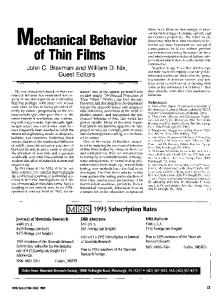Mechanical Testing of Free-Standing Thin Films
- PDF / 2,205,496 Bytes
- 12 Pages / 612 x 792 pts (letter) Page_size
- 83 Downloads / 407 Views
Mechanical Testing of Free-Standing Thin Films W. N. Sharpe, Jr. and K. J. Hemker Department of Mechanical Engineering, Johns Hopkins University, Baltimore, MD 21218 ABSTRACT An overview is given of methods for testing thin-film tensile specimens of either MEMS materials or surface coatings. MEMS specimens are deposited in a final shape and need only to be released for testing, while specimens of coating materials must be extracted. Very brief descriptions of the specimen designs, force application approaches, and strain measurements are given along with a limited number of references. Representative stress-strain curves for polysilicon, silicon nitride, silicon carbide, electroplated nickel and diffusion aluminide bond coating are presented. Results at high temperatures are presented for the latter two materials. INTRODUCTION When one sees the words ‘thin film’ in the title or abstract of a publication, the first impression is likely to be that it refers to coatings on a substrate. That is because the predominant application of thin films has been as protective coatings or as substructures of microelectronics. The introduction of microelectromechanical systems (MEMS) has changed that impression since the thin films involved must be free to move in most cases. In the case of MEMS, one must test the material without the constraining substrate because that is the way the components are used. In the case of coatings or microelectronics, it is useful to test the film itself since it is part of the composite system – recognizing of course that the interfaces may be the controlling factors. Table I is a very simplistic view of tests that are in use for MEMS materials and are applicable to any film from which a free-standing specimen can be produced. Only early references are listed here; there is a rich literature on each of the test methods. A ‘yes’ means the test method is used to measure the property, and a ‘no’ means that the property is not usually measured with this test method. Table I. Properties that can be measured by various test methods. Young’s modulus Bending [1,2] Resonant structure [3] Membrane [4] Snap-down [5,6] Tensile [7,8]
Poisson’s ratio
Strength
Residual Stress
Stress-Strain Curve
Yes
No
Yes
No
No
Yes
No
No
No
No
Yes
Yes
No
Yes
No
Yes
No
No
Yes
No
Yes
Yes
Yes
No
Yes
P6.6.1/B10.6.1
Bending tests can be either in-plane or out-of-plane, and the force-deflection is measured with either a specially constructed system or a commercial instrument such as a nanoindenter. Resonant structures are excited over a frequency range and a model of the system used to extract the material properties from the resonance peak. Membranes are pressurized on one side with the deflection measured on the other; well-established analyses relate the deformation to the properties. Snap-down tests are an important new concept for on-chip testing – a free strip of the film is attracted to the substrate by a voltage differential, which can be related to the properties. Mechanical properties of ductil
Data Loading...









